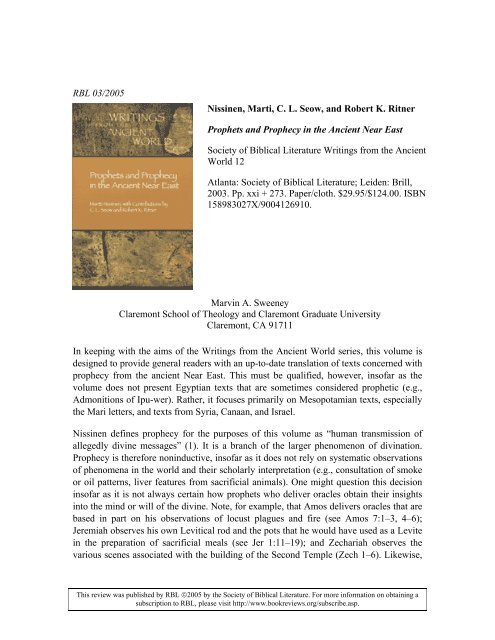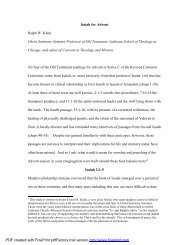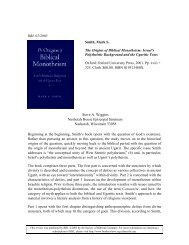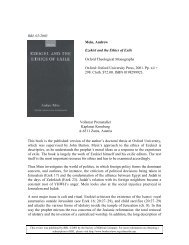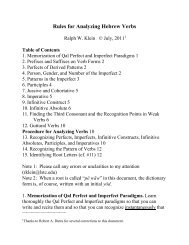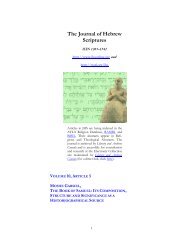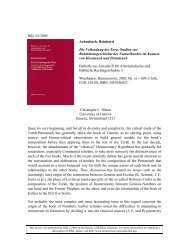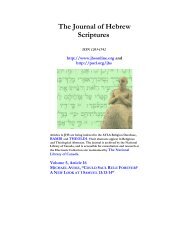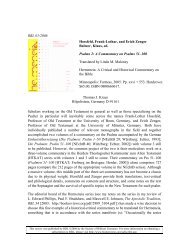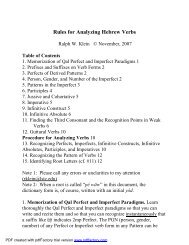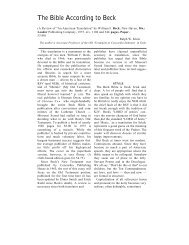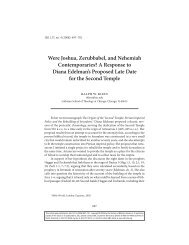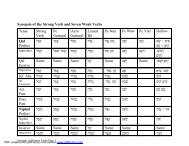RBL 03/2005 Nissinen, Marti, C. L. Seow, and Robert K. Ritner ...
RBL 03/2005 Nissinen, Marti, C. L. Seow, and Robert K. Ritner ...
RBL 03/2005 Nissinen, Marti, C. L. Seow, and Robert K. Ritner ...
Create successful ePaper yourself
Turn your PDF publications into a flip-book with our unique Google optimized e-Paper software.
<strong>RBL</strong> <strong>03</strong>/<strong>2005</strong><br />
<strong>Nissinen</strong>, <strong>Marti</strong>, C. L. <strong>Seow</strong>, <strong>and</strong> <strong>Robert</strong> K. <strong>Ritner</strong><br />
Prophets <strong>and</strong> Prophecy in the Ancient Near East<br />
Society of Biblical Literature Writings from the Ancient<br />
World 12<br />
Atlanta: Society of Biblical Literature; Leiden: Brill,<br />
20<strong>03</strong>. Pp. xxi + 273. Paper/cloth. $29.95/$124.00. ISBN<br />
158983027X/9004126910.<br />
Marvin A. Sweeney<br />
Claremont School of Theology <strong>and</strong> Claremont Graduate University<br />
Claremont, CA 91711<br />
In keeping with the aims of the Writings from the Ancient World series, this volume is<br />
designed to provide general readers with an up-to-date translation of texts concerned with<br />
prophecy from the ancient Near East. This must be qualified, however, insofar as the<br />
volume does not present Egyptian texts that are sometimes considered prophetic (e.g.,<br />
Admonitions of Ipu-wer). Rather, it focuses primarily on Mesopotamian texts, especially<br />
the Mari letters, <strong>and</strong> texts from Syria, Canaan, <strong>and</strong> Israel.<br />
<strong>Nissinen</strong> defines prophecy for the purposes of this volume as “human transmission of<br />
allegedly divine messages” (1). It is a branch of the larger phenomenon of divination.<br />
Prophecy is therefore noninductive, insofar as it does not rely on systematic observations<br />
of phenomena in the world <strong>and</strong> their scholarly interpretation (e.g., consultation of smoke<br />
or oil patterns, liver features from sacrificial animals). One might question this decision<br />
insofar as it is not always certain how prophets who deliver oracles obtain their insights<br />
into the mind or will of the divine. Note, for example, that Amos delivers oracles that are<br />
based in part on his observations of locust plagues <strong>and</strong> fire (see Amos 7:1–3, 4–6);<br />
Jeremiah observes his own Levitical rod <strong>and</strong> the pots that he would have used as a Levite<br />
in the preparation of sacrificial meals (see Jer 1:11–19); <strong>and</strong> Zechariah observes the<br />
various scenes associated with the building of the Second Temple (Zech 1–6). Likewise,<br />
This review was published by <strong>RBL</strong> ©<strong>2005</strong> by the Society of Biblical Literature. For more information on obtaining a<br />
subscription to <strong>RBL</strong>, please visit http://www.bookreviews.org/subscribe.asp.
the biblical portrayal of Balaam ben Beor (identified by scholars as a baru priest)<br />
indicates that he delivered oracles based in part upon his use of altars, which would have<br />
played a role in the deductive divination characteristic of baru priests. This last example<br />
is especially noteworthy because the volume includes the Deir ‘Alla inscription, which<br />
presents an oracle attributed to Balaam. Although the account of Balaam’s oracles in<br />
Num 22–24 is highly fictionalized, the remembrance of a foreign prophet as a diviner<br />
might well suggest to us some insight into the means by which such oracles were<br />
obtained. The Mari texts included in this volume present oracular statements by various<br />
types of prophets, but it is never clear what motivates them to speak. Can we simply<br />
assume that they work with some sort of divine inspiration—as is frequently supposed for<br />
the biblical prophets—or did they too depend upon some sort of deductive observation<br />
that our texts do not portray? <strong>Nissinen</strong> is aware of the problem <strong>and</strong> notes that our texts<br />
leave us in the dark concerning the social conditions in which the transmission of divine<br />
messages occurs. Indeed, the supposition that biblical prophets work without such<br />
observation is just as questionable as the above-noted examples would suggest.<br />
Texts included in the volume comprise three types: (1) oracle reports <strong>and</strong> collections that<br />
are clearly represented as divine communications; (2) quotations of prophetic messages<br />
in letters <strong>and</strong> other types of literature; <strong>and</strong> (3) texts with references to persons who have a<br />
prophetic title. Excluded texts include (1) those not entirely consistent with the definition<br />
of prophecy as transmission, such as the predictive Egyptian texts; (2) texts in which the<br />
reference to prophecy is yet to be established; <strong>and</strong> (3) several texts from Nuzi <strong>and</strong> Assur<br />
in which the term āpilu, “answerer,” commonly recognized as a prophetic title in the<br />
Mari texts <strong>and</strong> elsewhere, appears to have a different meaning. The various designations<br />
for prophets in these texts include the āpilum, “answerer,” who might possibly be a type<br />
of oracle diviner; the muhhûm, an ecstatic figure who sometimes seems to be<br />
indistinguishable from the āpilum; qammatum, an uncertain term that might refer to a<br />
distinctive hairstyle; the nabû, which may be related to biblical Hebrew nābî’; the assinu,<br />
a “man-woman,” who appears to change gender roles when speaking on behalf of a deity;<br />
<strong>and</strong> the Neo-Assyrian raggimu, “proclaimer,” who is especially—but not exclusively—<br />
associated with Ishtar of Arbela. The Zakkur <strong>and</strong> Deir ‘Alla inscriptions employ the term<br />
ḥzh, “visionary,” which actually refers to one who “perceives,” whether visually or<br />
aurally. Although the terms are suggestive of social roles, the texts unfortunately provide<br />
us only with scant information.<br />
Each text includes a transliteration of the original language, an English translation in very<br />
readable form; references to photographs, copies, transliterations, <strong>and</strong> translations;<br />
scholarly discussion of the text in question; <strong>and</strong> a set of very useful notes that guide the<br />
reader through idioms, philological issues, historical background, <strong>and</strong> the like. All of this<br />
This review was published by <strong>RBL</strong> ©<strong>2005</strong> by the Society of Biblical Literature. For more information on obtaining a<br />
subscription to <strong>RBL</strong>, please visit http://www.bookreviews.org/subscribe.asp.
is intended to serve the general reader, but scholars can employ these features with profit<br />
as well to track down both the general <strong>and</strong> the technical aspects of each text.<br />
The first group of texts presented in the volume includes fifty Mari letters that take up<br />
various aspects of prophecy as defined above. A brief introduction provides the historical<br />
details of the figures presented in the texts, such as the Mari kings Yasmah-Addu (ca.<br />
1792–1775 B.C.E.) <strong>and</strong> Zimri-Lim (1774–1760 B.C.E.), who appear so frequently<br />
throughout these texts; discussion of the prophetic titles employed; a survey of the<br />
contents of the various documents; <strong>and</strong> references to scholarly discussion. Many of the<br />
oracles <strong>and</strong> oracular reports in these documents deal with political <strong>and</strong> military matters,<br />
the building <strong>and</strong> maintenance of temples, the worship of deities, <strong>and</strong> performance of the<br />
divine will. Others concern private matters, such as Šelebum’s complaints about living<br />
quarters <strong>and</strong> food allotments (no. 8) or the deaths <strong>and</strong> namings of royal children (nos. 33,<br />
44). The primary concern throughout is the well-being <strong>and</strong> warfare of the king. He is<br />
frequently warned of plots <strong>and</strong> the dangers of going out on campaign. The rebellion of<br />
the Yaminites against Zimri-Lim is a concern, although <strong>Nissinen</strong> notes that the debate as<br />
to whether they are the binî Yamîna, “Benjaminites,” or mārû Yamîna, “kings/leaders of<br />
the Yaminites,” is duly noted. <strong>Nissinen</strong> favors the latter interpretation. Zimri-Lim’s war<br />
against Hammurabi is frequently mentioned, although this war ultimately led to Mari’s<br />
destruction. These documents are particularly important because they demonstrate the<br />
regular interaction between the royal house <strong>and</strong> prophets on a variety of questions.<br />
Prophets are legitimate <strong>and</strong> recognized counselors to the king on all major topics of<br />
governmental interest. They also point to the social location of prophets in relation to the<br />
temples of various deities, particularly Ishtar of Arbela.<br />
A second section presents fifteen other documents from Mari, including Ishtar rituals in<br />
which prophets <strong>and</strong> prophetesses take part; accountings of garments, donkeys, <strong>and</strong> other<br />
expenditures to prophets; <strong>and</strong> reports of criminal acts. These texts are particularly<br />
important because they highlight the professional status of prophets <strong>and</strong> their liturgical<br />
roles. Prophets are paid for their services; they are a professional class in ancient Mari.<br />
Section 3 includes the two Eshnunna oracles, which present the oracles of the goddess<br />
Kititum (a manifestation of Ishtar) to King Ibalpiel II of Eshnunna (r. 1779–1765 B.C.E.).<br />
Something of the process of oracular inquiry is evident here, as Kititum’s first oracle<br />
notes that she responds to the king with the secrets of the gods because he constantly<br />
pronounces her name. As result, she pronounces a šulmu or oracle of well-being that<br />
grants him power over the l<strong>and</strong> <strong>and</strong> ensures his throne—so long as his ear is attentive to<br />
her!<br />
This review was published by <strong>RBL</strong> ©<strong>2005</strong> by the Society of Biblical Literature. For more information on obtaining a<br />
subscription to <strong>RBL</strong>, please visit http://www.bookreviews.org/subscribe.asp.
Section 4 includes twenty-nine Nineveh oracles found in the remains of the royal Neo-<br />
Assyrian archive of Nineveh that was destroyed in 612 B.C.E. by the Babylonians <strong>and</strong><br />
Medes. The prophetic texts appear on two types of tablets, some of which are recorded<br />
individually <strong>and</strong> others that are collected together. The first represent a type of disposable<br />
document that was apparently used for an initial recording; the second was intended for<br />
long-term preservation. Some might see in this the origins of the writing of prophetic<br />
books, although the biblical books appear to have been more highly stylized to present an<br />
overall interpretation of the prophet <strong>and</strong> his times than the Neo-Assyrian collections<br />
would suggest. The documents were collected only by Kings Esarhaddon <strong>and</strong><br />
Assurbanipal, which suggests to <strong>Nissinen</strong> that they were the only kings to have<br />
prophecies filed away. We must be aware that these are the last kings of Assyria. We<br />
therefore cannot exclude the possibility that similar collections were made by earlier<br />
kings, either to be discarded later or simply not housed in Assurbanipal’s archives.<br />
Nevertheless, <strong>Nissinen</strong> notes that they are also the only Assyrian kings to be attentive to<br />
prophecy, which may be relevant for the emergence of classical prophecy in Israel during<br />
this period. The words of various deities appear throughout these documents, including<br />
Ishtar of Arbela, Bel, <strong>and</strong> Nabu, among others. The addressee is generally the king of<br />
Assyria, which points to a similar social role for prophets as that presented in the Mari<br />
letters. They cover a similar range of topics, <strong>and</strong> they emphasize the deliverance of šulmu<br />
oracles of well-being to the king in his various enterprises. The reassurance formula,<br />
“fear not!” appears frequently in these oracles as well as in biblical texts.<br />
Section 5 includes twenty-three other Neo-Assyrian documents that are relevant to the<br />
study of Mesopotamian prophecy. Documents include royal inscriptions, a succession<br />
treaty for Esarhaddon, royal correspondence, the so-called Marduk ordeal, administrative<br />
texts, <strong>and</strong> so forth. The royal oracles show strong support of the gods for Esarhaddon <strong>and</strong><br />
Assurbanipal. The Marduk ordeal was apparently related to the return of Marduk’s statue<br />
to Babylon <strong>and</strong> the rebuilding of the city at the beginning of Assurbanipal’s reign,<br />
although Assurbanipal probably regretted his decision when Babylon revolted in 652–<br />
648!<br />
Section 6 includes seventeen (not sixteen, as mentioned on 179) miscellaneous cuneiform<br />
sources, such as lexical lists, temple offerings, chronographic texts, omen texts, <strong>and</strong> the<br />
like. All refer in one form or another to prophets. The righteous sufferer from Ugarit is<br />
particularly important for its description of the prophets who bathe in their blood,<br />
apparently at mourning ceremonies. Such a text might help to explain the actions of<br />
Elijah’s opponents at Mount Carmel (1 Kgs 18).<br />
Section 7 includes six West Semitic texts prepared by C. L. <strong>Seow</strong>, including the Amman<br />
Citadel Inscription, the Zakkur Stele, the Deir ‘Alla text, <strong>and</strong> three Lachish ostraca. The<br />
This review was published by <strong>RBL</strong> ©<strong>2005</strong> by the Society of Biblical Literature. For more information on obtaining a<br />
subscription to <strong>RBL</strong>, please visit http://www.bookreviews.org/subscribe.asp.
Amman text dates to the ninth century <strong>and</strong> emphasizes Milcom’s protection of the city.<br />
The Zakkur Stele from the early eighth century presents Zakkur’s prayer to Baalshamayn<br />
for protection against enemies such as Bir-Hadah (Ben Hadad) of Aram <strong>and</strong> others. The<br />
eighth-century Deir ‘Alla inscription presents Balaam’s visions of the gods or the<br />
Shaddayin concerning coming disaster to the l<strong>and</strong>. This text has important implications<br />
for underst<strong>and</strong>ing the role <strong>and</strong> dating of Balaam ben Beor in Numbers. Finally, the<br />
Lachish ostraca present letters written by Judean military officers during the Babylonian<br />
siege of Lachish in 586 B.C.E.<br />
Section 8 presents the episode of a young man’s ecstatic prophecy from the Report of<br />
Wenamon. This section was prepared by <strong>Robert</strong> K. <strong>Ritner</strong> <strong>and</strong> represents an excerpt from<br />
his own forthcoming WAW volume on Egypt’s Third Intermediate Period.<br />
The volume concludes with concordances, bibliography, a glossary, <strong>and</strong> indices of names<br />
of people, places, terms for prophets, <strong>and</strong> so forth.<br />
Altogether, this is a very useful <strong>and</strong> readable volume that will well serve its intended<br />
audience of general readers as well as specialists in biblical studies, ancient Near Eastern<br />
studies, <strong>and</strong> other areas. Because of its extensive <strong>and</strong> accessible references to earlier<br />
studies, it will likely become the st<strong>and</strong>ard reference work for those interested in these<br />
texts.<br />
This review was published by <strong>RBL</strong> ©<strong>2005</strong> by the Society of Biblical Literature. For more information on obtaining a<br />
subscription to <strong>RBL</strong>, please visit http://www.bookreviews.org/subscribe.asp.


